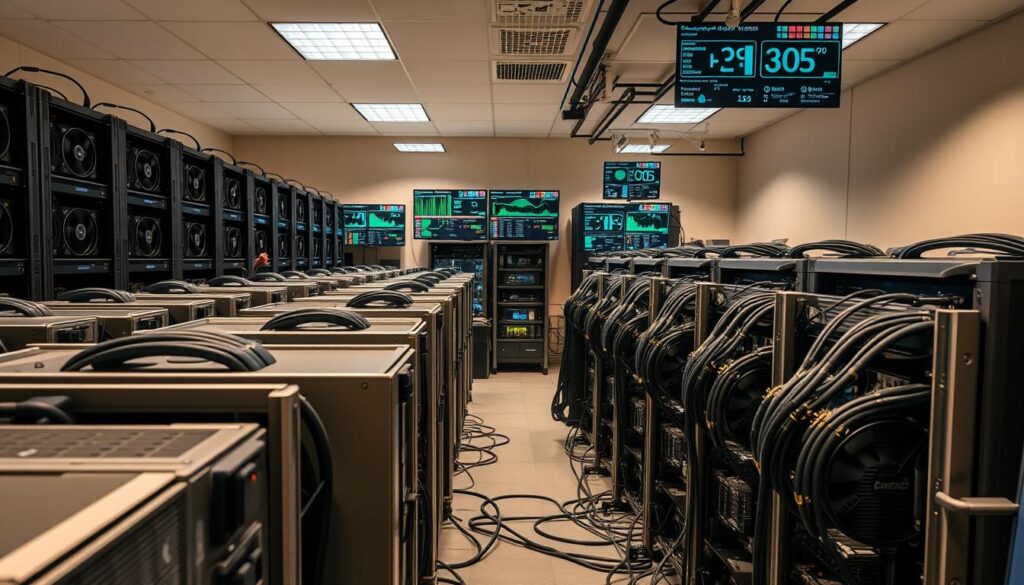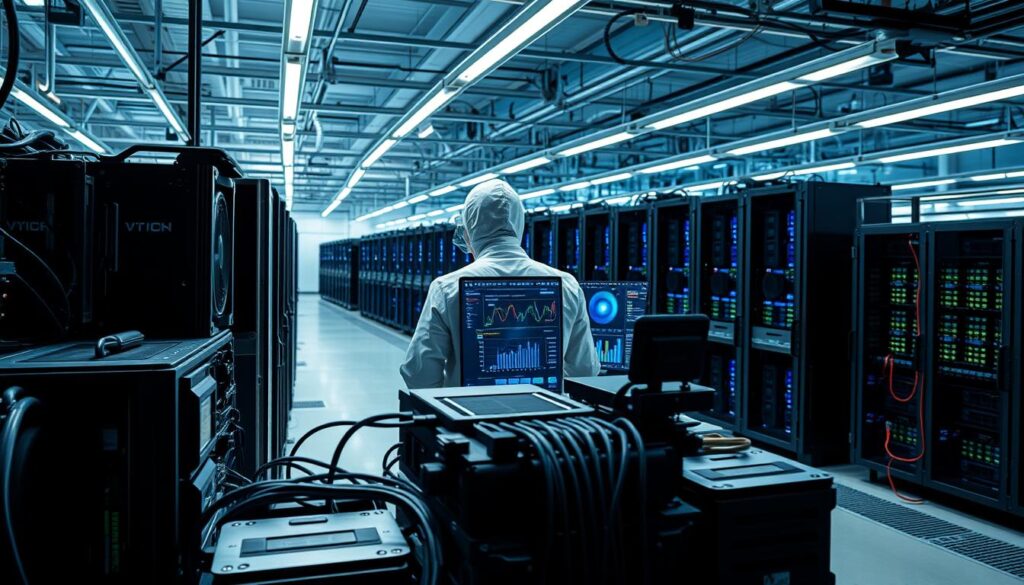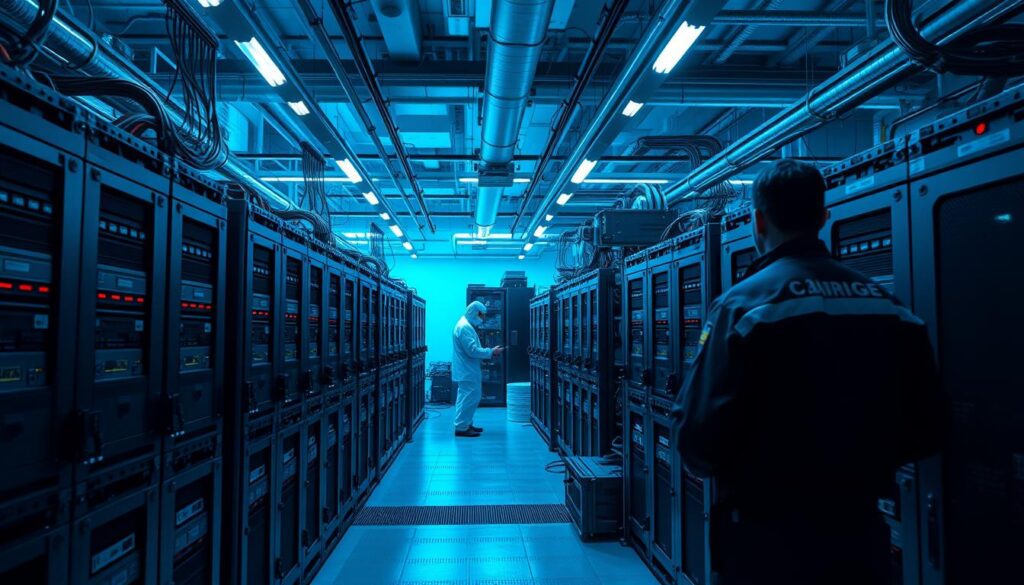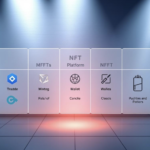Now Reading: Cryptocurrency Mining Explained: A Step-by-Step Guide
- 01
Cryptocurrency Mining Explained: A Step-by-Step Guide
Cryptocurrency Mining Explained: A Step-by-Step Guide

Cryptocurrency mining is a complex process that plays a crucial role in the blockchain network. As a beginner’s guide to cryptocurrency mining, this article will provide an overview of the key concepts and terminology involved in cryptocurrency mining explained. Understanding the basics of cryptocurrency mining is essential to navigating the world of blockchain and cryptocurrency.
For those new to cryptocurrency, a beginner’s guide to cryptocurrency mining is necessary to understand the process. Cryptocurrency mining explained in simple terms is the process of verifying transactions and adding them to the blockchain public ledger. This process requires significant computational power and energy, making it a complex and challenging task.
As we delve into the world of cryptocurrency mining, it’s essential to understand the importance of cryptocurrency mining explained in the context of the blockchain network. A beginner’s guide to cryptocurrency mining should cover the key concepts, including the role of miners, transaction verification, and blockchain consensus mechanisms. By providing a comprehensive cryptocurrency mining explained guide, we aim to educate readers on the process and its significance in the cryptocurrency ecosystem.
What Makes Cryptocurrency Mining Essential for Blockchain Networks
Cryptocurrency mining process plays a vital role in maintaining the integrity and security of blockchain networks. The benefits of cryptocurrency mining are numerous, and it is essential to understand how miners contribute to the network’s stability. Miners are responsible for verifying transactions, which helps to prevent fraudulent activities and ensures that the network operates smoothly.
The cryptocurrency mining process involves solving complex mathematical equations, which requires significant computational power. This process helps to secure the network by making it difficult for malicious actors to manipulate the blockchain. The benefits of cryptocurrency mining include the creation of new coins, which are rewarded to miners for their efforts, and the maintenance of the network’s security.
- Transaction verification: Miners verify transactions to ensure that they are legitimate and follow the rules of the network.
- Consensus mechanisms: Miners use consensus mechanisms, such as proof-of-work or proof-of-stake, to agree on the state of the blockchain.
- Network security: Miners help to maintain the network’s security by making it difficult for malicious actors to manipulate the blockchain.
In conclusion, the cryptocurrency mining process is essential for the integrity and security of blockchain networks. The benefits of cryptocurrency mining are numerous, and it is essential to understand how miners contribute to the network’s stability.
Cryptocurrency Mining Explained: Breaking Down the Process
To understand how does cryptocurrency mining work, it’s essential to break down the cryptocurrency mining process into its key components. The process involves preparing the necessary hardware and software, selecting a mining pool, and configuring the mining equipment. Once the equipment is set up, the mining process begins, where miners compete to solve complex mathematical equations and validate transactions.
The cryptocurrency mining process is crucial for the security and integrity of blockchain networks. Miners play a vital role in verifying transactions and creating new blocks, which helps to prevent double-spending and ensures the network’s stability. To learn more about the different methods of earning income in the crypto ecosystem, including trading, mining, staking, and lending, it’s essential to understand the underlying principles of cryptocurrency mining.
- Hardware selection and configuration
- Software installation and setup
- Mining pool selection and registration
- Transaction verification and block creation
By understanding these components, individuals can gain insight intohow does cryptocurrency mining workand make informed decisions about their involvement in the cryptocurrency market.
The Evolution of Mining: From CPU to ASIC
Cryptocurrency mining has undergone significant transformations since its inception. The journey from CPU mining to the current era of ASIC miners has been marked by advancements in technology, leading to improved efficiency and reduced power consumption. When it comes to selecting the best hardware for cryptocurrency mining, several factors come into play, including hash rate, power consumption, and durability of the cryptocurrency mining hardware.
First Generation: CPU Mining
The early days of cryptocurrency mining saw the use of Central Processing Units (CPUs) as the primary mining hardware. However, CPUs were soon found to be inefficient for mining due to their low hash rates and high power consumption.
GPU Mining Revolution
The introduction of Graphics Processing Units (GPUs) marked a significant turning point in the evolution of cryptocurrency mining. GPUs offered higher hash rates and better energy efficiency compared to CPUs, making them a popular choice among miners. The best hardware for cryptocurrency mining at that time was undoubtedly GPUs, which played a crucial role in the development of cryptocurrency mining hardware.
The ASIC Era
The current era of cryptocurrency mining is dominated by Application-Specific Integrated Circuits (ASICs). ASICs are designed specifically for cryptocurrency mining, offering unparalleled hash rates and energy efficiency. The use of ASICs has become the standard for large-scale mining operations, and their development has driven the growth of the cryptocurrency mining hardware industry.
In conclusion, the evolution of cryptocurrency mining hardware has been shaped by advancements in technology and the need for improved efficiency. As the industry continues to grow, the demand for the best hardware for cryptocurrency mining will drive innovation and development in the field of cryptocurrency mining hardware.
Essential Hardware Components for Mining Success
When it comes to cryptocurrency mining hardware, selecting the right components is crucial for a successful mining operation. The best hardware for cryptocurrency mining includes high-performance mining devices, reliable power supplies, efficient cooling systems, and suitable storage solutions.
A key factor in choosing the right hardware is considering the type of cryptocurrency being mined. Different cryptocurrencies have different mining requirements, and using the right hardware can significantly impact mining efficiency and profitability. For example, Bitcoin mining requires powerful ASIC miners, while Ethereum mining can be done using high-end graphics cards.
Some of the essential hardware components for mining success include:
- High-performance mining devices, such as ASIC miners or graphics cards
- Reliable power supplies that can handle high power consumption
- Efficient cooling systems to prevent overheating and damage to equipment
- Suitable storage solutions, such as hard drives or solid-state drives, to store mining software and data
Investing in the right cryptocurrency mining hardware can make a significant difference in mining success. By choosing the best hardware for cryptocurrency mining, miners can optimize their operations, reduce costs, and increase profitability.

| Hardware Component | Description |
|---|---|
| Mining Device | High-performance ASIC miner or graphics card |
| Power Supply | Reliable power supply that can handle high power consumption |
| Cooling System | Efficient cooling system to prevent overheating and damage to equipment |
| Storage Solution | Suitable storage solution, such as hard drive or solid-state drive, to store mining software and data |
Selecting the Right Mining Software
When it comes to cryptocurrency mining, having the right software is crucial for success. Cryptocurrency mining software plays a vital role in connecting miners to cryptocurrency mining pools and facilitating the mining process. With numerous options available, selecting the right software can be overwhelming.
To make an informed decision, it’s essential to consider factors such as compatibility, user interface, and security features. Popular mining software options include CGMiner, EasyMiner, and MultiMiner, each with its unique features and advantages.
Popular Mining Software Options
- CGMiner: A popular choice among miners, known for its flexibility and compatibility with various mining hardware.
- EasyMiner: A user-friendly option, ideal for beginners, with a simple and intuitive interface.
- MultiMiner: A versatile software, supporting multiple mining pools and algorithms.
Configuration and Setup Guidelines
Once you’ve selected a mining software, it’s essential to configure and set it up correctly. This includes specifying the mining pool, setting up the wallet, and configuring the mining hardware. By following the setup guidelines, you can ensure a smooth and efficient mining process.
Understanding Mining Pools vs Solo Mining
Cryptocurrency mining pools and solo mining are two approaches to mining cryptocurrencies. Cryptocurrency mining pools allow multiple miners to combine their resources and increase their chances of solving complex mathematical problems, while solo mining involves a single miner working alone.
The main difference between the two approaches is the distribution of rewards. In a mining pool, the rewards are shared among the participants, while in solo mining, the entire reward goes to the solo miner. Here are some key points to consider when deciding between cryptocurrency mining pools and solo mining:
- Increased chances of solving mathematical problems with mining pools
- Shared rewards in mining pools, potentially leading to more consistent earnings
- Higher potential earnings with solo mining, but also higher risks
- Greater control over the mining process with solo mining
Ultimately, the choice between cryptocurrency mining pools and solo mining depends on the individual miner’s goals, resources, and risk tolerance. By understanding the advantages and disadvantages of each approach, miners can make informed decisions and maximize their potential earnings.
Power Consumption and Cooling Requirements
Cryptocurrency mining profitability is heavily influenced by power consumption. As miners strive to maximize their earnings, they must also consider the environmental impact of their operations. Efficient cooling systems are essential to prevent hardware damage and reduce electricity costs.
When calculating electricity costs, miners must consider the power consumption of their hardware, as well as the cost of cooling systems. This can be a significant expense, and effective cooling solutions can help minimize costs. Some popular cooling solutions include air-cooled and liquid-cooled systems.
Calculating Electricity Costs
To calculate electricity costs, miners can use online tools or consult with energy experts. This will help them determine the most cost-effective cooling solutions for their operations.
Effective Cooling Solutions
Some effective cooling solutions for cryptocurrency mining include:
- Air-cooled systems
- Liquid-cooled systems
- Immersion cooling
Environmental Impact Considerations
Cryptocurrency mining operations must also consider the environmental impact of their power consumption. By using renewable energy sources and implementing sustainable practices, miners can reduce their carbon footprint and contribute to a more environmentally friendly industry.
Setting Up Your First Mining Operation
For those new to cryptocurrency mining, setting up a mining operation can seem daunting. However, with a beginner’s guide to cryptocurrency mining, you can easily get started. The first step is to choose the right hardware and software for your mining operation. This includes selecting a suitable mining rig, graphics card, and mining software.
When setting up your mining operation, it’s essential to consider the costs involved. This includes the cost of hardware, electricity, and maintenance. A beginner’s guide to cryptocurrency mining can help you understand these costs and make informed decisions. Additionally, you’ll need to configure your mining setup and join a mining pool, if desired.
Here are some key considerations when setting up your mining operation:
- Choose the right hardware and software for your mining operation
- Consider the costs involved, including hardware, electricity, and maintenance
- Configure your mining setup and join a mining pool, if desired
By following these steps and considering these key factors, you can successfully set up your first mining operation and start cryptocurrency mining. Remember to always follow best practices and stay up-to-date with the latest developments in the field of cryptocurrency mining.

| Hardware Component | Description |
|---|---|
| Mining Rig | A computer system designed specifically for cryptocurrency mining |
| Graphics Card | A component that handles the complex mathematical calculations required for cryptocurrency mining |
| Mining Software | A program that manages the mining process and connects to the blockchain network |
Mining Profitability Calculations and Considerations
Cryptocurrency mining profitability is a crucial aspect of the mining process. To determine mining profitability, calculations must be made considering various factors such as hash rate, difficulty, and market price. Mining profitability calculations involve assessing the revenue generated from mining and subtracting the costs incurred, including electricity and hardware expenses.
Understanding the factors that affect cryptocurrency mining profitability is essential for miners to make informed decisions. The hash rate and difficulty of the network, as well as the market price of the cryptocurrency, all play a significant role in determining profitability. By analyzing these factors, miners can project their return on investment (ROI) timeline and adjust their strategies accordingly.
Hash Rate and Difficulty Explained
The hash rate refers to the computational power of the mining hardware, while the difficulty is a measure of how hard it is to solve the complex mathematical equations required to validate transactions. A higher hash rate and lower difficulty can increase mining profitability.
ROI Timeline Projections
Miners can project their ROI timeline by calculating their daily revenue and subtracting their daily costs. This will give them an estimate of when they can expect to break even and start generating profits. Mining profitability calculations are essential for making informed decisions about mining operations.
Market Price Impact on Profits
The market price of the cryptocurrency has a significant impact on mining profits. A higher market price can increase revenue, while a lower market price can decrease it. Miners must consider the market price when making decisions about their mining operations to ensure they are maximizing their cryptocurrency mining profitability.
1. Key SEO keywords: Cryptocurrency mining challenges, mining solutions
2. HTML structure: h2, p, ul, img
3. Brand Voice: Informational tone
4. Draft content: Focus on common mining challenges and provide practical solutions
5. Formatting: Use bulleted lists, images, and italics for emphasis
6. Unique beginning: Start with a brief introduction to mining challenges
7. Keyword density: Ensure keywords are used naturally, below 2% density
8. HTML tags: Start with h2, use p for paragraphs, and ul for lists
9. Review and refine: Check word count, keyword density, and readability
10. Final content: Present the formatted HTML content
shortened content planning >
Common Mining Challenges and Solutions
Cryptocurrency mining challenges can be overwhelming, especially for new miners. Some common issues include hardware failures, software glitches, and network connectivity problems. To overcome these challenges, miners can use mining solutions such as regular hardware maintenance, software updates, and reliable internet connections.
Some other mining solutions include:
- Joining a mining pool to increase hashing power and reduce variability in rewards
- Using cloud mining services to reduce the need for hardware maintenance and upkeep
- Implementing security measures to protect against hacking and other cyber threats
By understanding the common cryptocurrency mining challenges and using effective mining solutions, miners can optimize their operations and increase their chances of success in the competitive world of cryptocurrency mining.
| Challenge | Solution |
|---|---|
| Hardware failure | Regular maintenance and replacement of faulty components |
| Software glitches | Regular software updates and troubleshooting |
| Network connectivity issues | Reliable internet connection and network monitoring |
Advanced Mining Strategies and Optimization
As miners gain experience, they often seek ways to improve their mining operations. Advanced cryptocurrency mining involves using specialized techniques to maximize efficiency and profitability. One key aspect of advanced mining is mining optimization, which entails fine-tuning hardware and software to achieve the best possible results.
Miners can employ several strategies to optimize their operations. Overclocking, for example, allows miners to push their hardware beyond its standard capabilities, resulting in increased hash rates and potentially higher profits. However, this must be done carefully to avoid damaging the equipment. Temperature management is also crucial, as high temperatures can reduce hardware lifespan and decrease performance.
Optimization Techniques
- Overclocking: increasing hash rates by pushing hardware beyond standard capabilities
- Temperature management: maintaining optimal temperatures to prolong hardware life and ensure peak performance
- Performance monitoring: using tools to track and analyze mining performance, identifying areas for improvement
By implementing these advanced mining strategies and optimization techniques, miners can significantly improve their operations and increase their chances of success in the competitive world of cryptocurrency mining. Advanced cryptocurrency mining and mining optimization are critical components of a successful mining operation, and by mastering these skills, miners can stay ahead of the curve and achieve their goals.
Advanced cryptocurrency mining requires a deep understanding of the underlying technology and a willingness to adapt to changing circumstances. By staying up-to-date with the latest developments and best practices, miners can ensure their operations remain competitive and profitable.
| Technique | Description |
|---|---|
| Overclocking | Increasing hash rates by pushing hardware beyond standard capabilities |
| Temperature management | Maintaining optimal temperatures to prolong hardware life and ensure peak performance |
| Performance monitoring | Using tools to track and analyze mining performance, identifying areas for improvement |
Security Measures for Mining Operations
Cryptocurrency mining security is a critical aspect of the mining process. As miners invest significant resources in their operations, protecting against hacking and data loss becomes essential. Implementing robust mining security measures can help prevent financial losses and maintain the integrity of the mining operation.
To ensure the security of their operations, miners should consider the following measures:
- Use secure wallets to store cryptocurrencies and mining rewards.
- Implement backup strategies to prevent data loss in case of hardware failure or hacking attempts.
- Utilize reliable antivirus software to protect against malware and other cyber threats.
By prioritizing cryptocurrency mining security and implementing effective mining security measures, miners can minimize risks and ensure the long-term success of their operations.

Tax Implications and Legal Considerations
Cryptocurrency mining taxes and legal considerations for mining are essential aspects of the mining process. As the cryptocurrency market continues to grow, miners must be aware of the tax implications and legal considerations for mining in their region.
In the United States, the IRS provides guidelines for reporting cryptocurrency mining income. Miners are required to report their income from mining on their tax returns, and they may be subject to self-employment taxes.
IRS Guidelines for Mining Income
The IRS considers cryptocurrency mining income to be taxable, and miners must report their income on their tax returns. The IRS also provides guidelines for calculating the value of mined cryptocurrency.
Regional Mining Regulations
Regional mining regulations vary, and miners must be aware of the regulations in their area. Some countries have laws that restrict or regulate cryptocurrency mining, while others have laws that support it.
Record Keeping Requirements
Miners must keep accurate records of their mining income and expenses, including records of the cryptocurrency they mine, the value of the cryptocurrency, and any expenses related to mining. This will help them to accurately report their income and expenses on their tax returns.
It is essential for miners to understand the tax implications and legal considerations for mining in their region to avoid any potential issues with the law. By following the IRS guidelines and regional regulations, miners can ensure they are operating within the law and avoiding any potential penalties.
| Region | Regulations |
|---|---|
| United States | IRS guidelines for reporting mining income |
| Europe | Varying regulations by country |
| Asia | Some countries have laws restricting mining |
Alternative Mining Methods: Cloud Mining and DeFi Staking
For those interested in mining but lacking the resources for traditional mining setups, alternative mining methods such as cloud mining and DeFi staking offer viable options. Cloud mining allows users to rent mining hardware and participate in mining operations without the need for physical equipment. DeFi staking, on the other hand, involves staking cryptocurrencies to participate in the validation process and earn rewards.
The pros and cons of these alternative mining methods include:
- Reduced hardware costs and energy consumption
- Increased accessibility for new miners
- Potential for higher returns through DeFi staking
- Risks associated with cloud mining, such as security concerns and lack of control
- Volatility of cryptocurrency markets and potential losses
Alternative mining methods, including cloud mining and DeFi staking, provide opportunities for individuals to participate in the mining process without significant upfront investments. By understanding the pros and cons of these methods, miners can make informed decisions about their involvement in the cryptocurrency mining landscape.
Mining Different Cryptocurrencies: Beyond Bitcoin
Mining different cryptocurrencies has become increasingly popular as the crypto market expands. Many miners are now looking beyond Bitcoin, exploring alternative cryptocurrencies to mine. This shift is driven by the desire to diversify mining operations and potentially increase profits. Mining different cryptocurrencies, such as altcoins, can provide miners with new opportunities and challenges.
When it comes to mining different cryptocurrencies, altcoin mining is a popular choice. Altcoins, such as Ethereum, Litecoin, and Dogecoin, offer varying levels of difficulty and potential rewards. Miners must research and understand the specific requirements and challenges associated with each altcoin to make informed decisions about their mining operations. For instance, Ethereum mining requires significant computational power and energy resources.
Some key considerations for mining different cryptocurrencies include:
- Hash rate and difficulty levels
- Block reward and transaction fees
- Network security and potential vulnerabilities
- Market demand and price volatility
By carefully evaluating these factors, miners can make informed decisions about which cryptocurrencies to mine and how to optimize their operations. As the crypto market continues to evolve, mining different cryptocurrencies will likely become even more important for miners looking to stay competitive and profitable.
The Future Landscape of Cryptocurrency Mining
As the cryptocurrency mining industry continues to evolve, experts anticipate several exciting trends that will shape its future. The rapid development of application-specific integrated circuits (ASICs) is expected to enhance mining efficiency, allowing miners to maximize their returns. Additionally, the emergence of innovative mining techniques, such as decentralized finance (DeFi) staking and cloud mining, will provide miners with more versatile options to participate in the ecosystem.
Regulatory changes will also play a crucial role in the future of cryptocurrency mining. Governments around the world are closely monitoring the industry, and their policies will significantly impact the viability and accessibility of mining operations. Miners must stay informed about regional regulations and adapt their strategies accordingly to ensure compliance and long-term sustainability.
As the demand for cryptocurrencies continues to grow, the competition among miners will intensify. Staying on the cutting edge of technology and optimizing energy efficiency will be essential for miners to maintain their competitive edge. The industry’s future will likely be shaped by a delicate balance between technological advancements, regulatory frameworks, and market dynamics, presenting both challenges and opportunities for those navigating the cryptocurrency mining landscape.
FAQ
What is cryptocurrency mining?
Cryptocurrency mining is the process of verifying and adding new transactions to the blockchain, the digital ledger that underpins cryptocurrencies. Miners use powerful computers to solve complex mathematical problems, and in return, they are rewarded with a small amount of the cryptocurrency they are mining.
Why is cryptocurrency mining essential for blockchain networks?
Cryptocurrency mining is essential for blockchain networks because it helps maintain the integrity and security of the network. Miners verify transactions, ensuring they are valid and preventing double-spending, and their work is essential for the consensus mechanism that underpins the blockchain.
How does the cryptocurrency mining process work?
The cryptocurrency mining process involves several key steps: 1) Preparing the mining hardware and software, 2) Joining a mining pool or mining solo, 3) Verifying transactions and solving complex mathematical problems, 4) Receiving the mining reward in the form of the cryptocurrency being mined.
How has the evolution of mining hardware affected the industry?
The evolution of mining hardware has significantly impacted the cryptocurrency mining industry. Starting with CPU mining, the industry moved to GPU mining, and then the introduction of ASIC (Application-Specific Integrated Circuit) miners revolutionized the field, making mining more efficient and profitable for those with access to the specialized hardware.
What are the essential hardware components for successful cryptocurrency mining?
The essential hardware components for successful cryptocurrency mining include the mining device (such as an ASIC or GPU), a reliable power supply, a cooling system to prevent overheating, and appropriate storage solutions to handle the large amounts of data generated by the mining process.
What are the best software options for cryptocurrency mining?
Some of the most popular mining software options include Geth (for Ethereum), CGMiner (for Bitcoin), and XMRig (for Monero). These software solutions provide the necessary tools to configure, monitor, and optimize the mining process, while also prioritizing security to protect against potential threats.
What are the differences between mining pools and solo mining?
Mining pools allow miners to combine their computational power and share the rewards, while solo mining involves an individual miner attempting to solve the complex mathematical problems on their own. The choice between mining pools and solo mining depends on factors such as the miner’s hardware, electricity costs, and desired level of risk versus potential reward.
How can miners calculate the profitability of their mining operations?
Miners can calculate the profitability of their mining operations by considering factors such as their hash rate, the network’s difficulty, electricity costs, and the current market price of the cryptocurrency being mined. This information can be used to project the potential return on investment (ROI) and make informed decisions about their mining operations.
What are some common challenges faced by cryptocurrency miners, and how can they be addressed?
Some common challenges faced by cryptocurrency miners include hardware failures, software issues, fluctuations in network difficulty and cryptocurrency prices, and the high energy consumption of mining operations. These challenges can be addressed through proper maintenance, software optimization, diversification of mining efforts, and the adoption of energy-efficient practices.
What are the tax implications and legal considerations for cryptocurrency mining?
Cryptocurrency mining income is generally considered taxable by the IRS, and miners must keep detailed records of their mining activities to comply with tax regulations. Additionally, miners should be aware of any regional regulations or restrictions that may apply to their mining operations, as the legal landscape surrounding cryptocurrency continues to evolve.
What are some alternative mining methods beyond traditional setups?
Alternative mining methods include cloud mining, where miners rent computing power from a third-party provider, and DeFi (Decentralized Finance) staking, where miners can participate in the verification of transactions on a blockchain network without the need for dedicated mining hardware.
Can miners diversify their efforts by mining different cryptocurrencies?
Yes, miners can diversify their efforts by mining different cryptocurrencies beyond just Bitcoin, such as Ethereum or various altcoins. Each cryptocurrency has its own unique mining requirements and characteristics, presenting different opportunities and challenges for miners to consider.
What does the future hold for the cryptocurrency mining industry?
The future of cryptocurrency mining is likely to be shaped by technological advancements, regulatory changes, and evolving market dynamics. Miners may face challenges such as increased competition, the potential shift towards more energy-efficient mining methods, and the possible introduction of new consensus mechanisms that could alter the mining landscape.















